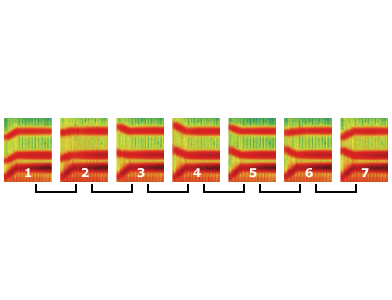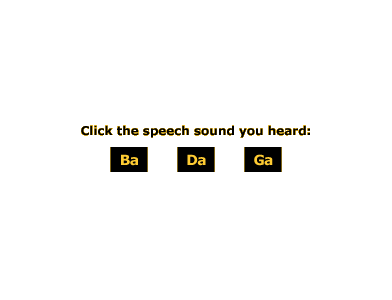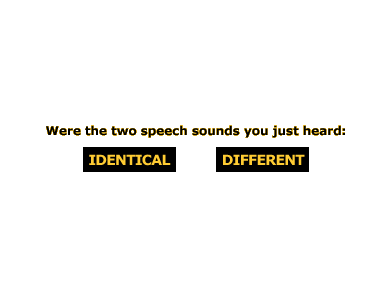Categorical Perception
Introduction
As we’ve seen a number of times in the last few chapters, gradually increasing a tone’s frequency also gradually increases the perceived pitch of the tone (e.g., the “gliding tones” in the Continuity and Restoration Effects activity). Similarly, gradually increasing a tone’s amplitude raises the level of perceived loudness. More generally, this is how most psychophysical relationships work: if you change the stimulus a small amount, you get a small change in the perceptual response to the stimulus.
For many speech sounds, however, this simple relationship does not hold; small changes can lead to large perceptual differences. Play, for example, the leftmost and rightmost speech sounds at left (labeled “1” and “7,” respectively; the images underneath each speaker are spectrograms of the sounds). You should hear them quite clearly as “Ba” and “Ga” respectively. (As with all the auditory activities, you will probably get the best results if you use headphones to listen to the sounds.) The other five sounds are computer-generated sounds equally spaced between the “Ba” and “Ga” sounds. If speech perception were just like frequency perception, you would hear these intermediate sounds as somewhat “Ba”-ish and somewhat “Ga”-ish. But if you try the sounds yourself, you should find that you hear the middle sound (labeled “4”) quite clearly as “Da,” and that you hear the other sounds as “Ba” or “Da” or “Ga,” but almost never as something in between.
This phenomenon, in which stimuli on a physical continuum are placed into a few highly distinctive categories, is called categorical perception. To demonstrate categorical perception in a laboratory, a researcher needs to conduct a two-part experiment:
- In the first part, called the identification phase, each stimulus is presented one at a time and subjects are asked to identify the stimulus as a member of one category or another. If the stimuli are perceived categorically, each one should almost always be placed in exactly one category. In other words, it should be very rare to find a stimulus that is placed in one category half of the time and in another category the other half of the time.
- In the second part, called the discrimination phase, pairs of stimuli are presented together and subjects are asked to decide whether or not they are the same or different. If the stimuli are perceived categorically, a stimulus pair should be easy to discriminate (i.e., easy to tell apart) if the two stimuli cross a category boundary. However, the stimuli should be very difficult to discriminate (i.e., subjects will claim they are the same sound) if they are both within the same category. (Question: How do we know whether or not two sounds are in the same category? Answer: We look at the results from the identification phase.)
That’s a pretty complicated set of results to understand just on the basis of a description, so this activity lets you try a categorical perception experiment for yourself. Start by doing some identification trials, then move on to try some discrimination trials. Check your results as often as you wish. You will need to do at least 20 trials of each type to see a stable pattern of results emerge, and the more trials you do, the better the chances that you’ll see a clear categorical perception pattern in your data.
Instructions
This activity includes several parts:
- An introduction, in which you can play sounds on the left side of the screen by clicking the speakers.
- Two experimental phases—identification trials and discrimination trials—in which you should follow the instructions above.
- Two pages describing the results. The first gives a detailed explanation of what everything on the left side of the screen means. The second describes what a prototypical pattern of results on this type of experiment would look like.
Identification Trials
In this phase of the experiment, you will hear one sound at a time. Your job is to decide whether you think each stimulus sounds more like “Ba,” “Da, ” or “Ga.”
- Click the START TRIAL button to begin. You’ll then hear a speech sound.
- The three choices (“BA,” “DA, ” “GA”) will appear on the screen. Click the syllable you think you just heard. There is no right or wrong answer. If you’re not totally sure which syllable you think it was, just make a guess.
- After you’ve made your choice, two more buttons will appear. Click the NEXT TRIAL button for another trial, or click the SHOW RESULTS button to view your results so far.
If possible, try to do at least 14 trials before viewing the results for the first time.
You have currently performed 0 trials.
Discrimination Trials
In this phase of the experiment, you will hear two sounds on each trial. Your job is to decide whether or not you think each pair of stimuli is identical.
- Click the START TRIAL button to begin. You’ll then hear one speech sound, followed by a 1.5 second delay, and then another speech sound. The two sounds may or may not be identical.
- Two choices, “IDENTICAL” and “DIFFERENT,” will then appear on the screen. If you thought the two speech sounds were exactly the same, click the IDENTICAL button. If you thought the two sounds were different (even if they sounded like the same syllable), click the DIFFERENT button. If you’re not sure, just take a guess.
- After you’ve made your choice, two more buttons will appear. Click the NEXT TRIAL button for another trial, or click the SHOW RESULTS button to view your results so far.
If possible, try to do at least 18 trials before viewing the results for the first time.
You have currently performed 0 trials.
Results, Part 1
The display at left shows the results for both phases (identification and discrimination) of our categorical perception experiment:
- Assuming you’ve done at least seven identification trials, letters just above the spectrograms show the consonant you’ve chosen most often for each speech sound (unless you’ve chosen two consonants equally often for a sound, in which case you’ll see a “?”). Roll your mouse over the speakers to show the exact results for each sound.
- Strips of color behind each speaker/spectrogram indicate how consistent you’ve been in the identification trials for each sound. Blue-shaded strips indicate “Ba” sounds, pink-shaded strips indicate “Da” sounds, and green-shaded strips indicate “Ga” sounds. The brighter the shades, the more consistent you’ve been (e.g., if you’ve always chosen “Ga” for a sound, the background for the sound will be a very bright green; if you’ve chosen “Ga” three times and “Da” twice, the background will be a pale green).
- Assuming you’ve done at least nine discrimination trials, you will see results for these trials below the spectrograms. Each black bracket and speaker indicates a pair of sounds you’ve heard. The number between the bracket and speaker shows the percentage of trials on which you correctly said that the two sounds were different. For example, if you heard a stimulus pair five times and claimed they were different on four of those trials, the percentage shown would be 80 percent. Roll your mouse over the speakers to show the exact results for each stimulus pair. (On three out of every nine trials, the sounds were actually identical.)
- If you’ve just completed a trial, you’ll see the stimulus or stimulus pair you heard on that trial indicated in blue.
- Click any of the speakers to hear the individual stimuli or stimulus pairs you’ve been hearing in the identification and discrimination trials.
Results, Part 2
If your results conform to a classic categorical perception pattern, here’s what you should see at left:
- Each of the spectrograms should have a bright color behind it: the two on the far left (sounds 1 and 2) should be blue (indicating that they were heard as “Ba”), the three in the middle (sounds 3, 4, and 5) should be pink (indicating that they were heard as “Da”), and the two on the far right (sounds 6 and 7) should be green (indicating that they were heard as “Ga”). This would mean that each stimulus was almost always categorized (identified) as one syllable or another.
- In the row of discrimination percentages below the spectrograms, the second and fifth stimulus pairs 2-3 and 5-6) should have high values (ideally, close to 100%), while the other pairs (1-2, 3-4, 4-5, and 6-7) should have much lower percentages. This would mean that when a stimulus pair crossed a category boundary, the two stimuli were easy to discriminate, whereas when both stimuli were within a category, they were difficult to discriminate.
Remember that the sounds in this activity were designed so that physically, the differences between the stimuli in each pair are identical. That is, the difference between speech sounds 5 and 6 is physically identical to the difference between sounds 6 and 7. But you are probably very good at discriminating sound 5 from sound 6, whereas sounds 6 and 7 sound very similar to you (trust us, these two sounds are physically different!). Furthermore, you probably almost always categorized sound 5 as “Da,” whereas you probably almost always categorized sounds 6 and 7 as “Ga.”
This is the essence of categorical perception: Small changes to the acoustic signal are easy to perceive when the change crosses a categorical boundary, but difficult to perceive when the two stimuli remain within the same category.
When experiments like the one you just tried were first run in the late 1960s, the fact that many types of speech sounds are perceived categorically was taken as evidence that humans have a special module in their brains for processing speech sounds. Since then, however, other researchers have found that: 1) nonhumans, such as chinchillas also show evidence for categorical perception of speech sounds, and that 2) other types of stimuli, such as musical chords and images of faces, are also perceived categorically.
Thus, categorical perception is neither limited to speaking organisms, nor is it limited to speech sounds. Current thinking is that many (if not most) types of stimuli can become categorically perceived if the organism doing the perceiving is required to categorize them often and has performed the categorization task over and over. Once the organism has developed sufficient expertise, perception becomes categorical. In this sense, speech sounds are special not because we have a brain module that does nothing besides process them, but because we have been exposed to them so often.











